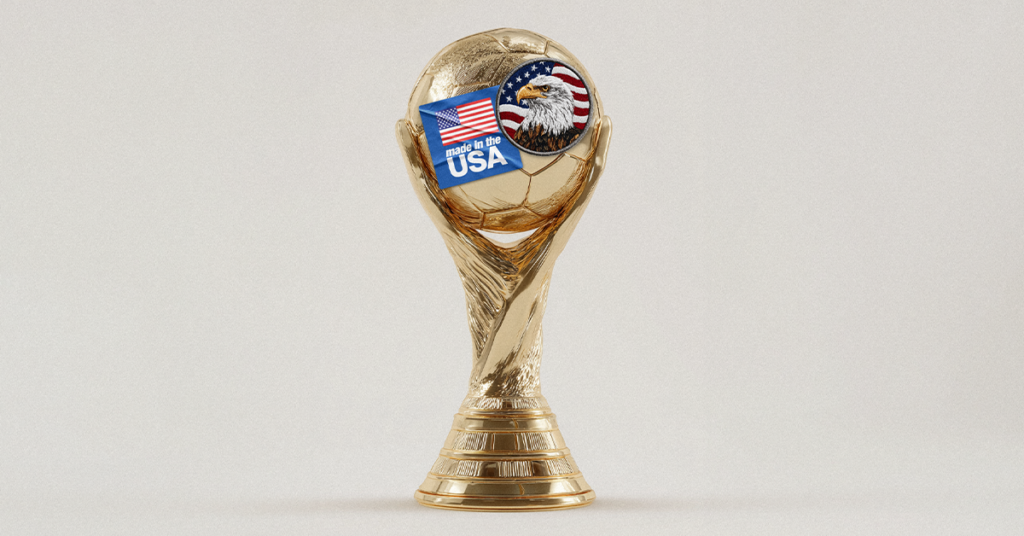The Cup is coming: Understanding opportunities across U.S. soccer’s big year

This summer’s FIFA Club World Cup delivered a memorable spectacle—complete with underdog stories, unexpected endings, attention-grabbing off-field drama, and world-class on-field performances. It also gave America a much-needed dress rehearsal for next summer’s World Cup.
The recently concluded FIFA Club World Cup—which saw Chelsea prevail over a field of 32 teams—was pitched as an ideal preview to the forthcoming 2026 tourney. It certainly provided a small glimpse of the action and fanfare that will fill various North American stadiums.
I had the chance to catch a couple of the matches, and I can attest to the atmosphere. Even as a Liverpool supporter, I couldn’t help but be struck by the droves of Real Madrid fans singing “Hala Madrid.”
Between the camaraderie, the sing-a-longs, the action on the pitch, and an average of around 40K fans at each match, there was real electricity, despite the headlines about empty seats early in the tournament. Along with my colleagues at The Martin Group, we can’t wait to see what’s in store for host cities like New York-New Jersey, Boston, Toronto, and Philadelphia once Cup action starts next June. If you live in the Northeast, like most of our team does, you’ll be within a relatively short drive or train ride from some of the biggest soccer matches our continent has ever seen.
For integrated communications firms like ours, our World Cup curiosity isn’t just because we’re sports fans. In recent years, we’ve worked with global brands like New Era Cap, Under Armour, and Nike; and over the past year, we have worked with Buffalo Pro Soccer to launch one of the newest additions to the USL Championship, coming in 2027. We’ve also partnered with brands outside of the traditional sports business to grow the impact of their sports partnerships. We understand this brand space well—but our interest is bigger than that.
This summer’s tournament—as well as the last two men’s and women’s World Cup affairs—provided learnings that can be instructive for our clients across all industries over the next 10 months and throughout next summer’s matches. This is inarguably the biggest sporting event in the world, and though just one nation will get to hoist the all-important trophy, there’s much at stake for companies in North America and far beyond. Billions of dollars in sales and exposure are on the line, as well as news opportunities, can’t-miss brand activations, customer breakthroughs, viral moments, and a wave of trends that could take shape between the tourney’s first and last goals.
So what have we learned that can guide strategies or give businesses and organizations a head start at becoming a part of the World Cup conversation? Let’s consider the following:
Ad lesson: The audience will be there. So will the money.
The 2022 World Cup generated an estimated $214 million in television ad revenue across the U.S., and companies across the globe spent an estimated $3 billion in the global ad industry during the 2018 World Cup. There’s a very simple reason for this spend: An escalating interest from potential customers. 2022’s tournament reached an estimated five billion people across the globe, more than a billion more than the 2018 World Cup; and the 2023 Women’s World Cup was watched by an estimated two billion as well. As for this past 2026 Club World Cup, nearly 2.5 million fans attended games in person, with another two billion watching on television or online.
These are real numbers, and all for a sport that’s (finally—what were you waiting for?) surging in popularity across the U.S. With companies like Nike spending nearly $148 million on the last World Cup, numbers for businesses of all sizes will likely surge for 2026, all based on the prospective audience in specific U.S., Canada, and Mexico locations, and around the world. The in-person, online, and broadcast attention lured by the Club World Cup—and year-round by MLS, NWSL, USL, and leagues globally—confirm that interest isn’t relegated to once every four years, either.
It’s now an overall interest in the game—and brands should be eager to become a part of the action.
PR lesson: Unifying event that brings global reach and local impact
The FIFA World Cup provides the opportunity to get brands in front of massive audiences, creating an incredibly large stage for public relations campaigns of all shapes and sizes.
The previously listed figures detail the number of eyeballs that could see brand messaging that’s connected with, adjacent to, or loosely linked with any element of World Cup action. It’s an association with something inherently beloved and unifying—at a time when media is more fragmented than ever and political postures are deeply entrenched. Through World Cup activations, brands can shape or transform their identity to mirror the essence of the event.
If you have a presence in one of the host cities—or the budget to launch activations in a host city—your opportunity to reach national and global audiences is only limited by your ingenuity and creativity. Consider these examples.
Michelob ULTRA went all out for the FIFA Club World Cup, launching their “Pitchside Club” in Midtown Manhattan — complete with media partnerships and brand collabs. The club featured a Hypebeast Kit Bar and hosted a live recording of the Men in Blazers podcast — two media platforms that are shaping soccer culture. The activation gained traction with earned and social media coverage.
Allstate took a different approach. They built on their partnership with U.S. Men’s National Team star and native Upstate New Yorker Tyler Adams, creating a community moment that could be linked to this past summer’s other major soccer tournament, the Concacaf Gold Cup. Working with Adams, Black Star, and the U.S. Soccer Foundation, Allstate debuted a new mini-pitch near Philadelphia as part of a multi-year commitment to increase access to safe play spaces in underserved communities. Making a difference by working together, this moment generated coverage and delivers a meaningful impact.
Those are big activations that required investments, but don’t let it intimidate you. Instead, extract the two lessons these activations provide — create experiences that facilitate authentic connections and find ways to deliver community impact through sports—especially if you can team up with an athlete.
If we look closer to home, Independent Health has made a massive difference for local kids through the Soccer for Success program that its foundation leads. And M&T Bank built a 40-year partnership with the Buffalo Bills (American football, as they say) to create real impact in Western New York, often alongside Bills players and legends.
Get creative in developing PR activations that can authentically connect your brand to fans ahead of the World Cup, and remember opportunities aren’t limited to host cities or the biggest companies. In your community, people will be looking for soccer experiences and ways to engage with fans closer to home.
A community financial institution could hold a workshop offering best practices on how to save for World Cup travel. A grocery store could promote international gameday recipes with an activation that creates a tailgate atmosphere outside their store. There’s also an abundance of opportunities to partner with local pro clubs and invest in youth programs and leagues.
This is just the beginning of America’s soccer movement — the World Cup is just your opportunity to get started if you haven’t already.
Social media lesson: Activate your influencers (and TikTok)
If recent World Cup and Club World Cup action is any indication, social media—and companies’ ability to use it well—will be a big factor for those looking to be a part of the 2026 conversation.
In 2022, World Cup action elicited nearly 94 million posts across all platforms, resulting in almost six billion engagements. The 2023 Women’s World Cup generated more than 185 million actions across all platforms, with the final match drawing 17 million actions and making TikTok the go-to platform for game video views. Throughout the recent Club World Cup, FIFA spent a significant portion of its $50 million marketing spend on social media, including partnerships with Instagram influencers across various interests to assure a diverse audience—and to grow its traditional fanbase.
When it comes to TikTok and its growth since the last FIFA World Cup, the platform has nearly doubled in global users in just three years, now boasting more than 1.5 billion. Over the past few years, this rise has brought unique value to sporting events, with its short-form video fare, fan interaction capabilities, and ability to generate live-event buzz. It brings more online culture to real-life sports moments. Businesses and organizations looking to enhance their reach should explore the platform and connect with its audience. And they should get started now, with still some time to spare before the tournament kicks off.
And when considering soccer’s global audience—and their central nature to this World Cup conversation—I call back to the words of Meg Kane, World Cup host city executive in Philadelphia. When asked by The Athletic about the top takeaway from this summer’s recent matches, Kane said, “If there’s any lesson from the Club World Cup, it is that fans win the day—so lean into that.”
The fans are the customers. The fans are the atmosphere. The fans are the market. The fans want your brand to do something new, something unique that will elevate their World Cup experience.
If this guides all strategy, then big gains can be made in and around The Beautiful Game.
Want to learn more about The Martin Group’s diverse array of work in the sports world? Click here.
